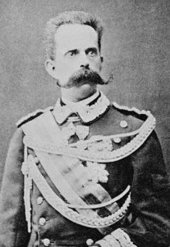Umberto I of Italy
|
|
| Template:House of Savoy |
Umberto I or Humbert I of Italy (Umberto Ranieri Carlo Emanuele Giovanni Maria Ferdinando Eugenio of Savoy, 14 March, 1844 – 29 July, 1900). Officially nicknamed "the Good", was the King of Italy from 9 January, 1878 until his death. He was deeply loathed in left-wing circles, especially among anarchists, because of his hard-line conservativism and support of the Bava Beccaris massacre in Milan. He was killed by anarchist Gaetano Bresci one year after the incident.
| Contents |
Youth
The son of Vittorio Emanuele II and of Adelaide, archduchess of Austria, Humbert was born in Turin, then capital of the kingdom of Sardinia, on March 14, 1844. His education was entrusted to, amongst others, Massimo Taparelli, marquis d'Azeglio and Pasquale Stanislao Mancini.
Since March 1858 he had a military career in the Sardinian army, beginning with the rank of captain. He was present at the battle of Solferino in 1859, and in 1866 commanded a division at the battle of Custoza.
On 21 April, 1868 Umberto married his cousin, Margherita Teresa Giovanna, Princess of Savoy. Their sons were Victor Emmanuel, prince of Naples; and Victor Emmanuel III of Italy.
Reign
Ascending the throne on the death of his father (January 9, 1878), Humbert adopted the title "Humbert I of Italy" rather than "Humbert IV" (of Savoy), and consented that the remains of his father should be interred at Rome in the Pantheon, and not in the royal mausoleum of Superga.
First murder attempt
While on a tour of the kingdom, accompanied by premier Benedetto Cairoli, he was was attacked by an anarchist, Giovanni Passanante, during a parade in Naples (November 17, 1878). The king warded off the blow with his sabre, but Cairoli, in attempting to defend him, was severely wounded in the thigh. The would-be assassin was condemned to death, but the king commuted the sentence to one of penal servitude for life. The incident upset the health of queen Margaret for several years.
Turmoil
The reign of Humbert I was a time of social upheaval, even though it was later claimed to have been a tranquil belle époque. Social tensions mounted as a consequence of the relatively recent occupation of the kingdom of the two Sicilies, spreading of socialist ideas, public hostility against the colonialist plans of the various governments, especially Crispi's, and the numerous crackdowns on civil liberties. Among the protesters, there was even the young, and then left-wing, Benito Mussolini.
Alliances and Colonialism
In foreign policy Humbert I approved the Triple Alliance with Austria-Hungary and Germany, visiting repeatedly Vienna and Berlin. Many in Italy, however, viewed with hostility an alliance with the former Austrian enemies in the independence wars, who were still occupying areas claimed by Italy.
He was also favourably disposed towards the policy of colonial expansion inaugurated in 1885 by the occupation of Massawa. He was suspected of aspiring to a vast empire in north-east Africa, a suspicion which tended somewhat to diminish his popularity after the disaster of Adowa on 1 March 1896.
The Bava Beccaris Incident
During the colonial wars in Africa, big demonstrations were held in Italy and on May 7, 1898 the city of Milan was put under military control by General Fiorenzo Bava-Beccaris, who ordered to use cannons on the demonstrators; as a result, about 100 people were killed according to the authorities (even though some claim the death toll was about 350); about a thousand were wounded. King Humbert sent a telegram to congratulate Bava Beccaris with the restoration of order and later decorated him with the medal of Great Official of Savoy Military Order, greatly outraging a large part of the public opinion.
To a limited extent his popularity was enhanced by the firmness of his attitude towards the Vatican, as exemplified in his telegram declaring Rome "intangible" (20 September, 1886), and affirming the permanence of the Italian possession of the "Eternal City".
Death
Being increasingly unpopular, Humbert I was victim of yet another murder attempt, by an unemployed ironsmith, Pietro Acciarito, who tried to stab him near Rome on 22 April, 1897.
Finally, he was murdered with four revolver shots by the italo-american anarchist Gaetano Bresci in Monza, on the evening of 29 July, 1900. Bresci claimed he wanted to revenge the people killed by Bava Beccaris. While the official propaganda gave him the nickname "the Good", this was hardly justified considered the support he gave to the repressive policies enacted during his reign.
He was buried in the Pantheon in Rome, by the side of Victor Emmanuel II, on 9 August, 1900. He was also the last Savoy being buried there, as his son and successor Victor Emmanuel the III died in exile.
External links
- External link: Genealogy of recent members of the House of Savoy (http://www.chivalricorders.org/royalty/gotha/italygen.htm)
Credits
- Some text originally from http://1911encyclopedia.org

